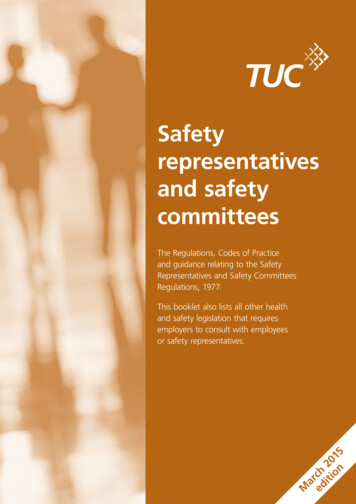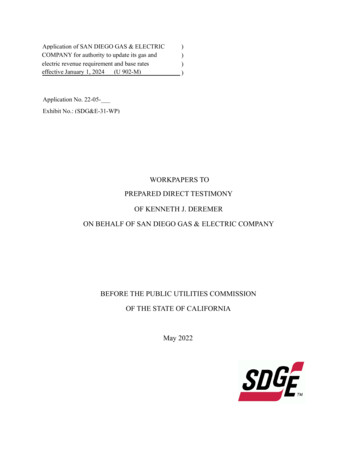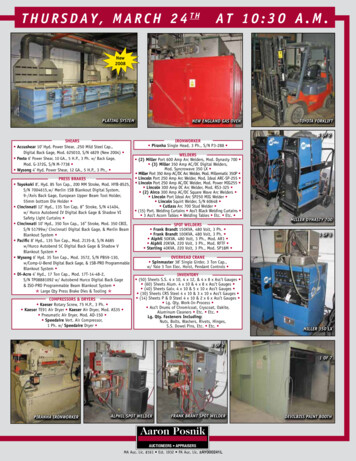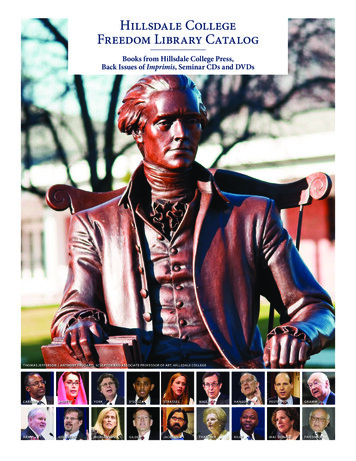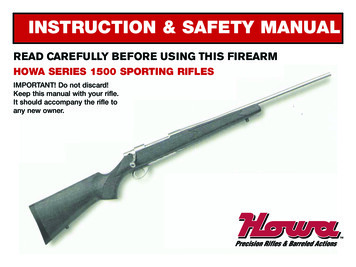
Transcription
INSTRUCTION & SAFETY MANUALREAD CAREFULLY BEFORE USING THIS FIREARMHOWA SERIES 1500 SPORTING RIFLESIMPORTANT! Do not discard!Keep this manual with your rifle.It should accompany the rifle toany new owner.
ABSOLUTELY, POSITIVELY THE FIRST STEPThe first step in the safe handling of any firearmis to know how to CLEAR it.The Howa rifle is considered CLEAR whenthere is no ammunition in the chamber or in themagazine, the bolt is open and the safety is "on".To clear the rifle:Point the muzzle in a safe direction. lift the bolthandle and pull the bolt fully to the rear. This shouldeject any cartridge that may be present in thechamber, but LOOK in the chamber anyway to besure it is empty. The magazine also is now exposed.If it con-tains any cartridges, remove them (seepage 17). Leave the bolt open and put the safety"on".Always clear your rifle before handing it toanother person. If someone hands a firearm to you,person-ally determine whether it is clear before anyfurther handling.Never assume any firearm to be unloaded, anddon't accept anyone's assurance. LOOK inside ityour-self. When entering or leaving a range orhunting area, or when showing the rifle to others,make sure the bolt is open, the safety is "on", andall ammunition has been removed. That way otherscan see, without need to operate its mechanism,that the rifle is clear.THESE WARNINGS ARE IMPORTANTFirearms, by their nature and intended function,are lethal weapons. By understanding the dangersinherent in the use of any firearm, and by takingproper precautions, you can enjoy complete safetyin the use of your firearm. Failure to heed any ofthese warnings may result in accidental death orserious injury to you or others, as well as severedamage to the firearm or other property.NOT JUST FOR BEGINNERSEven if you are familiar with other firearms,don't assume there is no need to study this manual.Accidents happen to experienced shooters aswell as beginners. Most of them could have beenavoided if the shooter had read and followed theinstructions and observed the basic rules of gunsafety.1IT'S YOUR RESPONSIBILITYHaving a firearm in your possession is likebeing the captain of a ship: it's a seriousresponsibility, and yours alone. It's up to you toKNOW how to keep and use your firearm safely,and up to you to always TAKE the necessaryprecautions - all of them. If you fail to do so, andsomeone gets hurt, the blame rests on you.
SAVE YOUR EYES AND EARSAlways wear protective shooting glasses andear plugs or "earmuff" type protectors wheneveryou are shooting. Your vision and hearing arepriceless, and irreplaceable. Always make certainthat persons close to you are similarly protected.Shooting glasses will protect your eyes fromburns and abrasions caused by powder gas,metallic particles, burning powder grains, lubricant,and similar debris that can emanate occasionallyfrom any firearm in normal use. If something goesseriously wrong and fragments of cartridge case orfirearm are sent flying, shooting glasses can makethe difference between future sight and blindness.The best compromise between protection andconvenience is offered by high-quality shootingglasses or industrial-grade safety glasses withlarge-area shatter-resistant polycarbonate lenses atleast 2mm thick.Without ear protection, repeated exposure toshooting noise may lead to cumulative, permanenthearing loss. Many experienced shooters who valuetheir hearing wear both ear plugs AND ear muffs.At a shooting range it is common courtesy not tocommence firing until everyone nearby has theireyes and ears covered.Remember: Accidents are rarely the fault of thefirearm. A gun is just a machine, with no judgmentof its own. It responds to your actions, whetherwise or foolish. Of course it has mechanical safetyfeatures, but none as effective as the brain of acautious shooter who never forgets that a moment'scarelessness can produce a permanent tragedy.TRAINING IS ESSENTIALThe safe handling of firearms requiresspecialized training, knowledge and discipline. Thebest way to learn is with supervised instruction,often available from gun shops, gun clubs, statehunter safety programs or police departments. Forhelp in finding a training course, write to theNational Rifle Association, 11250 Waples MillRoad, Fairfax, Virginia 22030.GUNS ARE NOT ALL ALIKEMany makes and models of firearms might looknearly the same. However, they differ widely indesign and operation, and in the location andfunction of various controls.Study this manual. Thoroughly educate yourselfon the characteristics and operation of thisparticular firearm before attempting to load it. Donot permit others to have access to your rifle unlessthey have received proper instruction.2
1.2.3.4.5.6.7.8.9.10.11.12.13.14.15.Muzzle of barrelBarrelFloor plateFloor plate catchTrigger guardTriggerStockSling swivel studButt end of stockBolt handleCocking Piece(with firing pin)Bolt sleeveBoltReceiverSafety16. Red dot indicator17. Bolt stop18. Magazine(inside stock)19. Chamber endof barrelImportant Terms Which Are Not Individual Parts:Bore: The hole lengthwise through the barrel through which a fired bullet passes.Chamber: The enlarged rear portion of the bore into which a cartridge is seatedfor firing.Muzzle: The front face of the barrel from which the bullet emerges.Magazine: The space inside the rifle where cartridges are stored to be fed intothe chamber. Left, Right, Front, and Rear refer to the rifle as seen by ashooter holding it in the firing position.3
TECHNICAL SPECIFICATIONSType andCaliberSporting.223 Rem.22-250 Rem.243 Win6.5x55.25-06270 Win.30-06.308 WinVarmint.223 Ram.22-250 Rem.308 WinMagazineCapacityBarrelLengthOverallLengthRate 01:91:101:101:101:12SIGHTSSince most users wish to select a particulartelescopic sight and mount combination thatsatisfies their individual preferences andrequirements, your Howa rifle I. delivered from thefactory without sights. Mounting holes are factorydrilled and tapped to accommodate many popularmakes and models of telescopic lights and mounts.Follow the manufacturer’s instructions for properinstallation and :12Big Game Magnum7mm Rem Mag 3.300 Win Mag 3.338 Win Mag :101:121:9.5555LEAD EXPOSURE Discharging firearms inpoorly ventilated areas, cleaning firearms, orhandling ammunition may result in exposure tolead and other substances known to the state ofCalifornia to cause birth defects, reproductiveharm, and other serious physical injury. Haveadequate ventilation at all times. Wash handsthoroughly after exposure. SHOOTING ORCLEANING GUNS MAY EXPOSE YOU TOLEAD.4
TO AVOID A CATASTROPHEALWAYS keep the muzzle pointed in a safedirection. Never point any gun – loaded or unloaded– at anything you are not willing to see destroyed.ALWAYS assume every gun is loaded until youpersonally prove otherwise. Don't trust yourmemory, and never take anyone's word for it.ALWAYS hold your gun so that you can controlthe direction of the muzzle if you fall or stumble.ALWAYS keep the safety "ON" and your fingeroutside the trigger guard until the muzzle is pointedat the target and you are ready to fire.ALWAYS keep the gun unloaded until it mustbe ready for use. If there is no need to load it untillater, don't.ALWAYS pay attention where the muzzle ispointing when you (or others nearby) are handlingany gun, especially while operating any part of itsmechanism. Don't let anyone point the muzzle in anunsafe direction (for example: at you).ALWAYS check for any obstruction in thebarrel before loading or if there is any reason tosuspect blockage. Bore obstructions are a majorsource of gun explosions.ALWAYS positively identify your target and besure there is a safe backstop before you shoot. It'sfar better than making pathetic excuses afterward.5ALWAYS hold your gun so that you can controlthe direction of the muzzle if you fall or stumble.ALWAYS use high quality ammunition made toAmerican industry standards. Make sure it is clean,dry, in good condition, and of the proper type andcaliber for your gun. Defective or improperammunition is responsible for most malfunctionsand blown-up guns.NEVER mix alcohol or drugs with shooting.There is enough danger without the added hazardof fuzzy judgment.NEVER pull a gun toward you by grasping itsmuzzle end. If the rifle snags on something andfires, the bullet probably won't miss.NEVER attempt to load or unload a gun insidea vehicle or building (except a properly constructedindoor range); there usually is no safe direction topoint the muzzle.NEVER shoot at a hard object or at waterexcept under carefully controlled conditions. Bulletscan glance off hard materials like rock, glass orsteel, or skip off the surface of water, fly inunpredictable directions – and kill.NEVER leave an unattended gun loaded. Gunsand ammunition should be stored separately, lockedand beyond the reach of children and carelessadults.
AMMUNITION1. Use only high quality, original factorymanufactured ammunition. Do not use cartridgesthat are dirty, wet, corroded, bent, or damaged.Use only ammunition of the caliber for which yourfirearm is chambered. The proper caliber ispermanently engraved on your firearm; neverattempt to use ammunition of any other caliber.4. Make a habit of regularly examining your firedcartridge cases, particularly when trying differentammunition. Watch for abnormalities: punctured,loose, or excessively flattened primers; split,deformed or partially separated cases; rough orcratered firing pin indents, torn rims, etc. "Reading"the cases can reveal a lot about the quality of theammunition and the condition of the rifle, allowingcorrective steps to be taken before something uglyhappens.2. Do not oil cartridges, or spray aerosollubricants, preservatives or cleaners directly ontocartridges or where excess spray might come intocontact with them. Highly penetrative lubricants canmigrate inside cartridge cases and contaminate theprimer and/or propellant powder. Either a misfire ora failure of the powder to ignite may result. If onlythe primer ignites, there is danger that the bulletmay not exit the barrel, and obstruct the bore.5. Don't mix up ammunition. Keep cartridges intheir original box until you are ready to load them.When afield, carry only one caliber of ammunition inyour pockets. At the range, put only the ammunitionfor the firearm you are currently using on theshooting bench. Don't put ammunition of differentcalibers or loads in the same box or loose in arange bag. It is too easy to pick up and load thewrong cartridge, with potentially disastrous results.3. Store ammunition in a cool, dry place, awayfrom sources of heat. Heat shortens the shelf life ofammunition by accelerating the chemicaldecomposition of primer and propellant.6
AMMUNITIONWARNING!Excessive pressure in the barrel when a shotis fired can blow up even the strongest firearm,and cause death or serious injury to the shooter orothers nearby.Even at normal firing pressure (often in excessof 50,000 pounds per square inch), if the cartridgecase bursts the uncontrolled escape of propellantgas from the barrel into the receiver area can beextremely dangerous. Explosions from excessivepressure or burst cartridge cases are mostcommonly caused by defective or improperammunition or by an obstruction in the barrel. (Seewarnings in following section, "BoreObstructions".)storage. Corrosion, dirt or other foreign matter ona cartridge can impede complete locking of thebolt, and in combination with other faults mayresult in a burst cartridge case; the same is true ofa cartridge that is oversized, damaged ordeformed. Another defect is a bullet that is loosein the case neck; this condition introduces a highrisk of a bore obstruction.Improper cartridges are those of the wrongcaliber or loading for normal use in a particularfirearm.FOR SAFETY, USE ONLY CLEAN, DRY,HIGH QUALITY AMMUNITION IN GOODCONDITION MANUFACTURED ANDASSEMBLED TO INDUSTRY STANDARDSBY REPUTABLE MANUFACTURERS,AND OF THE CORRECT CALIBER ANDLOADING FOR YOUR FIREARM.Defective cartridges may be overloaded orunderloaded, incorrectly dimensioned, improperlymanufactured or assembled, or assembled fromthe wrong or faulty components. Defectiveammunition also includes cartridges that are dirty,wet, corroded, bent, split, damaged, contaminatedwith lubricant, or deteriorated from age or poor7
WARNING ON RELOADED AMMUNITIONSuch problems seldom arise from originalfactory-made ammunition from major manufacturerswho have the experience and facilities to produce itcorrectly. It is much safer to use only originalfactory-made cartridges, and you are emphaticallyurged to do so.Some intrepid souls nonetheless will choose touse reloaded ammunition. They should understandthat they are embracing an extra and potentiallylethal risk, and must accept full responsibility ifinjury results.The use of reloaded (or "handloaded","remanufactured", or other non-standard)ammunition is far and away the most commoncause of dangerous malfunctions and blown upfirearms.Reloading is a complex science whichunfortunately is not as fully understood by many ofits practitioners as it deserves to be. It also requiresa high order of quality assurance which many haveneither the specialized knowledge nor theequipment to establish and maintain.A reloaded cartridge is no better than theknowledge, skill and care of the person who madeit. The process is endless of seemingly minordetails that, if not gotten right, can produce a majordisaster. A cartridge that is improperly resized,primed, charged or assembled, or made from thewrong, defective or outdated components, can beextremely dangerous in many ways. It can slam-fire,cause a bore obstruction, produce a malfunctionthat sets the stage for an accidental discharge,inflict progressive damage to the gun, or suddenlyblow it up.HOWA AND LEGACY SPORTSINTERNATIONAL WILL ACCEPT NORESPONSIBILITY WHATSOEVER FORANY PERSONAL INJURY OR DAMAGETO THE RIFLE OR OTHER PROPERTYARISING FROM THE USE OFRELOADED AMMUNITION.8
BORE OBSTRUCTIONSAn obstruction from a stuck bullet can occur if:WARNING! The cartridge has been improperly loaded withinsufficient or no propellant powder, or thepropellant fails for any reason to ignite.(Ignition of the primer alone will push thebullet out of the cartridge case but usuallydoes not generate sufficient energy to drivethe bullet out the muzzle), or The bullet is not properly seated tightly in thecartridge case. If such a cartridge is extractedfrom the chamber without being fired, thebullet may be left behind in the bore at thepoint where the rifling begins. Attempting tochamber another cartridge may push the firstbullet ahead into the bore (or telescope thesecond bullet rearward into its cartridgecase), making room for the bolt to close. Ifthis cartridge is then Fired an explosion willalmost certainly result.Barrel obstructions, especially from a bullet stuckin the bore, are a major cause of firearmexplosions and can cause death or serious injuryto the shooter or others nearby. Immediately stopshooting and check the barrel for a possibleobstruction whenever: You have difficulty, or feel unusualresistance, when chambering a cartridge, or A shot sounds weak or abnormal, or Unburned grains of propellant powder arediscovered spilled in the mechanism, or You retract the bolt to eject an unFired (ormisfired) cartridge from the chamber, butonly the cartridge case comes out.If you have any reason to suspect that a bullet isobstructing the barrel, immediately unload thefirearm and look through the bore. It is not sufficientto merely look in the chamber. A bullet may belodged some distance down the barrel where itcannot easily be seen.In such instances a bullet may be lodged inthe barrel. Firing a subsequent bullet into theobstructed barrel can produce an explosion.9
BORE OBSTRUCTIONS (continued)Soil, mud, snow, water, ice, vegetation,mudwasp nests, etc. are all dangerous inside a gunbarrel. If the muzzle of your riRe comes into contactwith the ground, or you have reason to suspect thatsomething has gotten into the barrel, unload the rifleand look through the bore. It's not enough to justlook at the muzzle; debris can slide some distanceinside where it can't easily be seen. If anything isthere, clean it out with a rod. Never attempt toshoot it out; the barrel may burst and you could beseriously hurt.If a bullet is in the bore, DO NOT try to shoot itout by using another cartridge, or by blowing it outwith a cartridge from which the bullet has beenremoved, or with a blank cartridge. Unburnedpowder trapped in the bore behind the stuck bulletcan detonate in the confined airspace withdevastating results.Often a bullet lodged in the barrel can beremoved by gently tapping it out with a Rat-tippedbrass rod that closely Fits the bore diameter. Don'tuse a cleaning rod, as it is likely to bend or deformand become jammed in the bore. Unburned powderand other fouling probably will be left in the bore. Itis imperative that the bore, chamber, and receiverbe thoroughly cleaned to remove all such residuebefore shooting is resumed.If the bullet cannot be readily dislodged, takethe firearm and the ammunition to a gunsmith. Donot use any more ammunition from that lot until bothhave been examined and the cause of theobstruction determined.10
USE OF THE SAFETY: TWO POSITIONThe safety on the Model 1500 rifle consists of aknurled lever on the right side of the receiverimmediately to the rear of the bolt handle. When"on", it locks the trigger. Its purpose is to preventfiring if the trigger is pressed inadvertently. It shouldnot be relied upon to prevent accidental dischargefrom other causes. See page 13.A. The safety is "on" when the lever (15) ispushed fully rearward, covering the red indicatordot in the stock.B. The safety is "off" when the lever is pushedforward, uncovering the red indicator dot (16).Do not carry the rifle with a cartridge loaded inthe chamber without first placing the safety "on".Keep the safety "on" until you are ready to fire andthe rifle is pointed at the target.Note: The safety can be placed "on" only whenthe rifle is cocked, I.e., ready to fire (Fig. 4). Youcan see whether it is cocked from the position ofthe cocking piece (11). When cocked, the rear ofthe cocking piece protrudes from the back of thebolt sleeve (12).11
USE OF THE SAFETY:TWO POSITION (continued)When the rifle is uncocked, the cocking piece(11) is recessed approximately 3/8th of an inchinside the bolt sleeve (12). In order to place thesafety "on" from this position, the rifle must first becocked by raising the bolt handle fully upward, thenclosing it again.The safety operates directly on the triggermechanism. For this reason, the trigger adjustmentshave been sealed at the factory. Any attempt tochange these adjustments may render the safetyinoperative and create a hazardous condition.WARNING!1. Do not touch the trigger while operating thesafety. Pulling the trigger while the safety lever isbeing pushed "off" will cause the firing pin to bereleased as soon as the "off" position is reached;if a cartridge is present in the chamber, the riflewill fire.2. Keep the muzzle pointed in a safe directionwhen operating the safety. Malfunctions whichmay cause a gun to fire as the safety is engagedor disengaged are rare but can happen. Even ifan accidental firing should occur, nobody will behurt if you follow this rule.3. The red indicator dot is for familiarization helponly. For safe gun handling, learn by feel thepositive "on" and "off" position of the safety lever.When engaging the safety, move the lever fullyinto the "on" position. Do not rely on merelylooking at the dot: the safety might not be fullyengaged.12
USE OF THE SAFETY:TWO POSITION (continued)It is important to recognize that no firearm canbe absolutely safe from firing if it is dropped when acartridge is present in the chamber. Like anycomplex tool having small parts, a gun can bedamaged or broken, and its safety mechanismsdefeated, if it is subjected to sufficient abuse suchas being dropped on a hard surface.3 RULES TO REMEMBER ABOUT A SAFETY1. NEVER TOTALLY DEPEND ON AMECHANICAL SAFETY. It is not a substitutefor proper gun handling. Like all mechanicaldevices the safety is subject to breakage ormalfunction and can be defeated by wear, abuse,dirt, corrosion, incorrect assembly of the firearm,improper adjustment or repair, or lack ofmaintenance. See Warning on page 12.You can largely eliminate the risk of a dropfire by taking the simple precaution ofkeeping the chamber empty until you areready to actually shoot.2. NO MECHANICAL SAFETY IS"CHILDPROOF" OR "FOOLPROOF". Nosafety ever invented can be relied upon toprevent an accidental shooting by a determinedchild or a grownup idiot "playing" with a gun.However, you can and should take elementaryprecautions to secure your firearm fromunauthorized handling. See page 27.If you do drop your firearm, unload it and haveit checked by a competent gunsmith to be surethere is no internal damage that would render itunsafe or unreliable.3. TREAT EVERY GUN AS IF YOU EXPECTITS MECHANICAL SAFETY NOT TO WORK.You will be astounded at how cautious youbecome, and how little tolerance you will havefor the complacency of others.13
Use of The Safety: Three PositionThe new 3 position safety works the same asthe 2 position safety in the first 2 safety positions"ON" and "OFF". In the new 3rd safety position (allthe way to the rear), the safety is "ON" and the boltcannot be opened.To summarize, the three positions in the newsafety are as follows:1. The safety is "OFF" when the lever (17) ispushed fully forward, uncovering the red indicatordot (18) in the stock.2. The safety is "ON" when the lever is pushedto the middle position, covering the red indicatordot. The bolt may be opened in this position for safeloading or unloading.3. The safety is "ON" when the lever is pushedfully rearward, covering the red indicator dot. In thisposition, the bolt is locked and cannot be opened.WARNING: Do not screw in trigger guardwhen bolt is in gun.14
LOADINGWARNING!1. While loading (and at all times!) make sure themuzzle is pointed in a safe direction!2. Risk of an accident is greatly increased whenany firearm, no matter how safely designed, iscarried with the cartridge in the chamber. Unlessthe firearm must be ready for immediate firing,leave the chamber empty. Load the chamber onlywhen you are ready to actually shoot.3. Always point the muzzle in a safe direction whenmanually operating the action to load the firstcartridge from the magazine into the chamber.Malfunctions which allow the gun to fire as the boltis closed without the trigger being pulled are rarebut can happen.Enclosed areas frequently offer no completely safedirection to point the firearm; if an accidentaldischarge occurs, there is great risk of injury orproperty damage.5. Before loading, always clean all grease, oil,solvent, etc. from the bore and chamber. When abullet is fired, an accumulation in the bore orchamber of any lubricant or other incompressiblefluid (including, for example, rainwater) can cause abulge or burst barrel or other damage to the rifleand result in serious injury to the shooter or toothers nearby. In addition, any coating of lubricantin the chamber interferes with the adhesionbetween cartridge case and chamber wall that isnecessary for safe firing, and subjects the rifle tostress similar to that imposed by excessivepressure.4. Never attempt to load or unload any firearminside a vehicle, building or other confined space(except a properly constructed shooting range).15
LOADINGBeginning with the rifle empty and uncocked:1. Point the muzzle in a safe direction! Lift the bolthandle and pull the bolt to the rear until it stops. Putthe safety "on". Check the chamber to make sure itis empty.2. Press cartridges down into the magazine one ata time as shown in Fig. 5 until the magazine is full(5 cartridges in standard calibers, 3 in magnumcalibers, 6 in .223 caliber).3. If you intend to commence shooting immediately,push the bolt back forward and turn the handledown to its original position. In its forwardmovement, the bolt will pick up the top cartridge inthe magazine and feed it into the chamber for firing(Fig. 61. The rifle is ready to fire as soon as thesafety is pushed" off").4. If you will not be shooting immediately, minimizeany risk of accidental firing by leaving the barrelchamber empty until you are actually prepared tofire. Follow the loading procedure under "closingthe bolt without loading the chamber" (Figs. 7and 8).16
LOADINGLoading an extra cartridgeIn certain hunting situations you may wish toload the rifle with one cartridge more than themagazine capacity. This is accomplished byinserting an extra cartridge directly into the chamberbefore closing the bolt. To prevent the bolt fromalso attempting to chamber the top cartridge in themagazine as the bolt moves forward, depress thecolumn of cartridges in the magazine as shown inFig. 7 and close the bolt on the extra cartridge.leave the safety "on"!Closing the bolt without loading the chamberAfter loading the magazine but before closingthe bolt, depress the column of cartridges in themagazine with your fingers while slowly sliding thebolt about half way forward so that it overrides thetop cartridge (Fig. 7). Now, remove your fingersand finish closing the bolt, watching to make surethat no cartridge is pushed into the chamber (Fig.8). leave the safety "on"!Single loadingYou may also use the rifle as a single-shot byplacing one cartridge at a time directly into thechamber (or into the magazine) and closing the bolt.leave the safety "on"!17
UNLOADING1. Point the rifle in a safe direction! The safetyshould be kept "on"!2. Lift the bolt handle and gently pull the bolt to therear. This will extract any unFired cartridge presentin (j) the chamber. Remove this cartridge from therifle and leave the bolt open.3. Empty the magazine from below (Fig. 9). Holdone hand loosely under the floor plate to restrain it,and depress the Floor plate catch 141. The hingedFloor plate will pop open, allowing the cartridges tobe dumped into your hand. Look in the magazineand chamber to be sure that all the cartridges havebeen removed.WARNING!1. Always LOOK in the chamber to make sure the cartridge has been extracted and the chamber is empty.It is rare for a cartridge to remain stuck in the chamber, but it can happen.2. It is recommended that you always empty the magazine by the method described above. Do not emptythe magazine by cycling the bolt, since this process involves feeding cartridges into the chamber, andintroduces an additional risk of an accidental firing.18
FIRINGWhile shooting any firearm, an unfired cartridgeor fired cartridge case might become jammedbetween the bolt and the barrel. Clear the rifle asfollows. Keep the muzzle pointed in a safe directionand, if possible, the safety on. Pull the bolt fullyrearward. The jammed cartridge can then beshaken out or picked out with your fingers. Discardany cartridge that is dented or that has the bulletshoved back into the cartridge case.With a cartridge loaded in the barrel chamberand the safety "on": Point the rifle at the target,push the safety "off", take aim, and fire bysqueezing the trigger.To fire the next shot, open the bolt and pull itsmartly to the rear. This cocks the firing mechanismand ejects the spent cartridge case from theprevious shot. Pushing the bolt forward again feedsthe next cartridge into the chamber, and turning thebolt handle downward closes the bolt. The rifle isnow ready to fire again. This process can berepeated until the rifle is empty. If you wish totemporarily cease firing before the rifle is empty,immediately put the safety "on". "Immediately"means before you turn the muzzle away from thedirection of the target.If you have finished shooting, immediatelymake the rifle safe by unloading it completely.Extensive dry firing (snapping the firingmechanism without a cartridge in the chamber) isnot recommended as it may result in breakage ofthe firing pin. After making sure the rifle is empty,the rifle may be uncocked without dry firing bylifting the bolt handle, then pressing and holding thetrigger while lowering the bolt handle.19
FIRINGWARNING!1. Keep the muzzle pointed in a safe direction, thesafety "on", and your finger away from the triggeruntil you are ready to fire.Take the firearm and the ammunition to a gunsmithfor examination.4. Never uncock the rifle with a cartridge in thechamber. This is an unsafe condition, as the firingpin would then be in direct contact with the primerof the chambered cartridge. An impact on the boltcould then cause the rifle to fire accidentallywithout the trigger being pulled.2. Never carry about or leave unattended anyfirearm which is cocked and ready to fire! Whencocked and with the safety off, it can easily fire ifthe trigger is pressed. An accidental dischargecould result if you fall or drop the firearm, or ifsome external object contacts the trigger.3. If while shooting, your firearm develops anymechanical malfunction or binding, or "spits"powder gas, or if a cartridge primer is puncturedor a cartridge case is bulged or ruptured, or if thereport on firing does not sound quite right, stopshooting immediately! It may be dangerous tocontinue. Unload the firearm - do not try "one moreshot to see if it does it again". (It probably will, butworse. It is amazing how often serious accidentsare preceded by warning signs that are ignored).5. Do not allow other persons to stand beside youwhere they might be struck by an ejected cartridgecase. The case is hot, and may be ejected withsufficient force to cause a burn or cut or injure anunprotected eye.20
DISASSEMBLYFirst make sure the rifle i
7mm Rem Mag 3 24" 44.5" 1:9.5.300 Win Mag 3 24" 44.5" 1:10.338 Win Mag 3 24" 44.5" 1:10 Ultralight.243 5 20" 40.0" 1:10.308 5 20" 40.0" 1:12.7mm-08 5 20" 40.0" 1:9.5 SIGHTS Since most users wish to select a particular telescopic sight and mount combination that satisfies their individual preferences and






